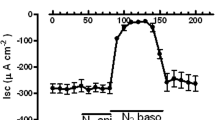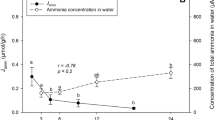Summary
Potentials measured in isolated, perfused gills fromPlatichthys suggest that the electrogenic ion-pump(s) contribute significantly to the potential measured in seawater. Copper added to the perfusate causes a significant reduction in the potential measured in the isolated gill and it is suggested that this is due to a direct inhibition of the branchial ion pump(s). Vascular resistance was unaffected by the presence of copper. Ouabain-sensitive oxygen consumption was reduced in tissue exposed to copper whereas residual oxygen consumption was unaffected, which suggests that the in vitro action of copper is confined to the Na+, K+ ATPase dependent portion of branchial metabolism.
In vitro application of copper to gill homogenates fromPlatichthys flesus adapted to seawater caused a marked reduction in Na+, K+ ATPase activity. In vivo a combination of ouabain binding (to determine the number of enzyme sites), together with measurements of Na+, K+ ATPase activity showed that exposure of the fish to ambient copper in seawater also inhibited enzyme activity. However this response was modulated by a reduction in the sensitivity of the enzyme to copper in copper-treated fish and also responses, possibly of an endocrine nature, modifying Na+, K+ ATPase activity and returning overall enzyme levels to values not significantly different from those in control fish.
In addition, this study indicates the importance of obtaining information on both the number of enzyme sites as well as their overall activity in assessing the effects of agents modifying enzymes involved in ion transport.
Similar content being viewed by others
References
Amico Martell AL de, Cech JJ (1978) Peripheral vascular resistance in the gills of the winter flounder,Pseudopleuronectes americanus. Comp Biochem Physiol [A] 59:419–423
Bader H, Wilkes AB, Jean DH (1970) The effect of hydroxylamine, mercaptans, divalent metals and chelators on (Na++K+)-ATPase: A possible control mechanism. Arch Biochem Biophys 101:37–46
Booth JH (1979) The effects of oxygen supply, epinephrine and acetyl choline on the distribution of blood flow in trout gills. J Exp Biol 83:31–39
Bouquegneau JM (1977) ATPase activity in mercury intoxicated eels. Experientia 23:941–943
Butler DG, Carmichael FJ (1972) (Na++K+)-ATPase activity in eel (Anguilla rostrata) gills in relation to changes in environmental salinity: role of adrenocorticol steroids. Gen Comp Endocrinol 19:421–427
Cech JJ, Rowell DM, Glasgow JS (1977) Cardiovascular responses of the winter flounder,Pseudopleuronectes americanus, to hypoxia. Comp Biochem Physiol [A] 57:123–125
Christensen GM, McKim JM, Brungs WA, Hunt EP (1972) Changes in the blood of brown bullhead (Ictalurus nebulosus, Le Sueur) following short and longterm exposure to copper (II). Toxicol Appl Pharmacol 23:417–427
Dixon DG, Sprague JB (1981) Copper bioaccumulation and hepatoprotein synthesis during acclimation to copper by juvenile rainbow trout. Aquatic Toxicol 1:69–81
Donaldson EM (1981) The pituitary-interrenal axis as an indicator of stress in fish. In: Pickering AD (ed) Stress and fish. Academic Press, London, pp 11–48
Donaldson EM, Dye HM (1975) Corticosteroid concentrations in sockeye salmon exposed to low concentrations of copper. J Fish Res Board Can 32:533–539
Epstein FH, Katz AI, Pickford GE (1967) Sodium and potassium activated adenosine triphosphatase of gills. Role in adaptation of teleosts to salt water. Science NY 156:1245–1247
Evans DH (1980) Kinetic studies of ion transport by fish gill epithelium. Am J Physiol 238:R224–R230
Evans DH, Mallery CH, Kravitz L (1973) Sodium extrusion by a fish acclimated to seawater: physiological and biochemical description of a Na-for-K exchange system. J Exp Biol 58:627–636
Farrell AP, Daxboeck C, Randall DJ (1979) The effect of input pressure and flow on the pattern and resistance to flow in the isolated, perfused gill of a teleost fish. J Comp Physiol 133:233–240
Hemmerich P (1966) Model studies on univalent copper in proteins. In: Peisach J, Aisen P, Blumberg WE (eds) Biochemistry of copper. Academic Press, London, pp 15–32
Johnson DW (1973) Endocrine control of hydromineral balance in teleosts. Am Zool 13:799–818
Karnaky KJ, Kinter LB, Kinter WB, Stirling CE (1976) Teleost chloride cell II. Autoradiographic localisation of gill Na, K-ATPase in killifish,Fundulus heteroclitus adapted to low and high salinity environments. J Cell Biol 70:157–171
Kuhnert PM, Kihnert BR (1976) The effects of in vivo chromium exposure on Na/K- and Mg-ATPase activity in several tissues of the rainbow trout (Salmo gairdneri). Bull Environ Contam Toxicol 15:383–390
Maetz J (1971) Fish gills: mechanisms of salt transfer in freshwater and seawater. Philos Trans R Soc Lond [Biol] 262: 209–249
Mazeaud MM, Mazeaud F, Donaldson EM (1977) Primary and secondary effects of stress in fish: some new data with a general review. Trans Am Fish Soc 106:201–212
McKim JM, Christensen GM, Hunt EP (1970) Changes in the blood of brook troutSalvelinus fontinalis after short-term and long-term exposure to copper. J Fish Res Board Can 27:1883–1889
Motais R, Isaia J (1972) Evidence for an effect of ouabain on the branchial sodium-excreting pump of marine teleosts: interaction between the inhibitor and external Na and K. J Exp Biol 57:367–373
Niebor E, Richardson DPS (1980) The replacement of the non descript term “heavy metals” by a biologically and chemically significant classification of heavy metal ions. Environ Pollut B 1:3–45
Payan P (1978) A study of the Na+/NH +4 exchange across the gill of the perfused head of the troutSalmo gairdneri. J Comp Physiol 124:181–188
Peters J (1966) Effects of copper on pigeon brain. In: Peisach J, Aisen P, Blumberg WE (eds) Biochemistry of copper. Academic Press, London, pp 175–183
Pic P (1978) Na and Cl excretion by gills ofMugil capito andFundulus heteroclitus — effects of stress. J Comp Physiol 123:155–162
Pickford GE, Pang PKT, Weinstein E, Torreth J, Hendler E, Epstein FH (1970) The response of hypophysectomised cyprinodont,Fundulus heteroclitus, to replacement therapy with cortisol: Effects on blood serum and sodium-potassium activated adenosine triphosphatase in the gills, kidney and intestinal mucosa. Gen Comp Endocrinol 14:524–534
Riedel B, Christensen G (1979) Effects of selected water toxicants and other chemicals upon ATPase activity in vitro. Bull Environ Contam Toxicol 23:365–368
Sargent JR, Thompson AJ (1974) The nature and properties of the inducible sodium-plus-potassium ion-dependent adenosine triphosphatase in the gills ofAnguilla anguilla adapted to freshwater and seawater. Biochem J 144:69–75
Schreck CB, Lorz HW (1978) Stress response of coho salmon (Oncorhynchus kisutch) elicited by cadmium and copper and potential use of cortisol as an indicator of stress. J Fish Res Board Can 35:1124–1129
Sheppard K, Simkiss K (1978) The effects of heavy metal ions on Ca2+ ATPase extracted from fish gills. Comp Biochem Physiol [B] 61:69–72
Shuttleworth TJ (1978) The effects of adrenaline on potentials in the isolated gills of the flounder (Platichthys flesus L.). J Comp Physiol 124:129–136
Shuttleworth TJ, Potts WTW, Harris JN (1974) Bioelectric potentials in the gills of the flounderPlatichthys flesus. J Comp Physiol 94:321–329
Silva P, Solomon R, Spokes K, Epstein FH (1977) Ouabain inhibition of gill Na−K-ATPase: relationship to active chloride transport. J Exp Zool 199:419–426
Stagg RM, Shuttleworth TJ (1982a) The accumulation of copper inPlatichthys flesus L. and its effects on plasma electrolyte concentrations. J Fish Biol 20:491–500
Stagg RM, Shuttleworth TJ (1982b) Na+, K+ ATPase, ouabain binding and ouabain-sensitive oxygen consumption in gills fromPlatichythys flesus adapted to seawater and freshwater. J Comp Physiol 147:93–99
Stekhoven FS, Bonting SL (1981) Transport adenosine triphosphatase: properties and functions. Physiol Rev 61:1–76
Watson TA, Beamish FWH (1980) Effects of zinc on branchial ATPase activity in vivo in rainbow trout,Salmo gairdneri. Comp Biochem Physiol [C] 66:77–82
Watson TA, Beamish FWH (1981) The effects of zinc on branchial adenosine triphosphatase enzymes in vitro from rainbow trout,Salmo gairdneri. Comp Biochem Physiol [C] 68:167–173
Author information
Authors and Affiliations
Rights and permissions
About this article
Cite this article
Stagg, R.M., Shuttleworth, T.J. The effects of copper on ionic regulation by the gills of the seawater-adapted flounder (Platichthys flesus L.). J Comp Physiol B 149, 83–90 (1982). https://doi.org/10.1007/BF00735718
Accepted:
Issue Date:
DOI: https://doi.org/10.1007/BF00735718




